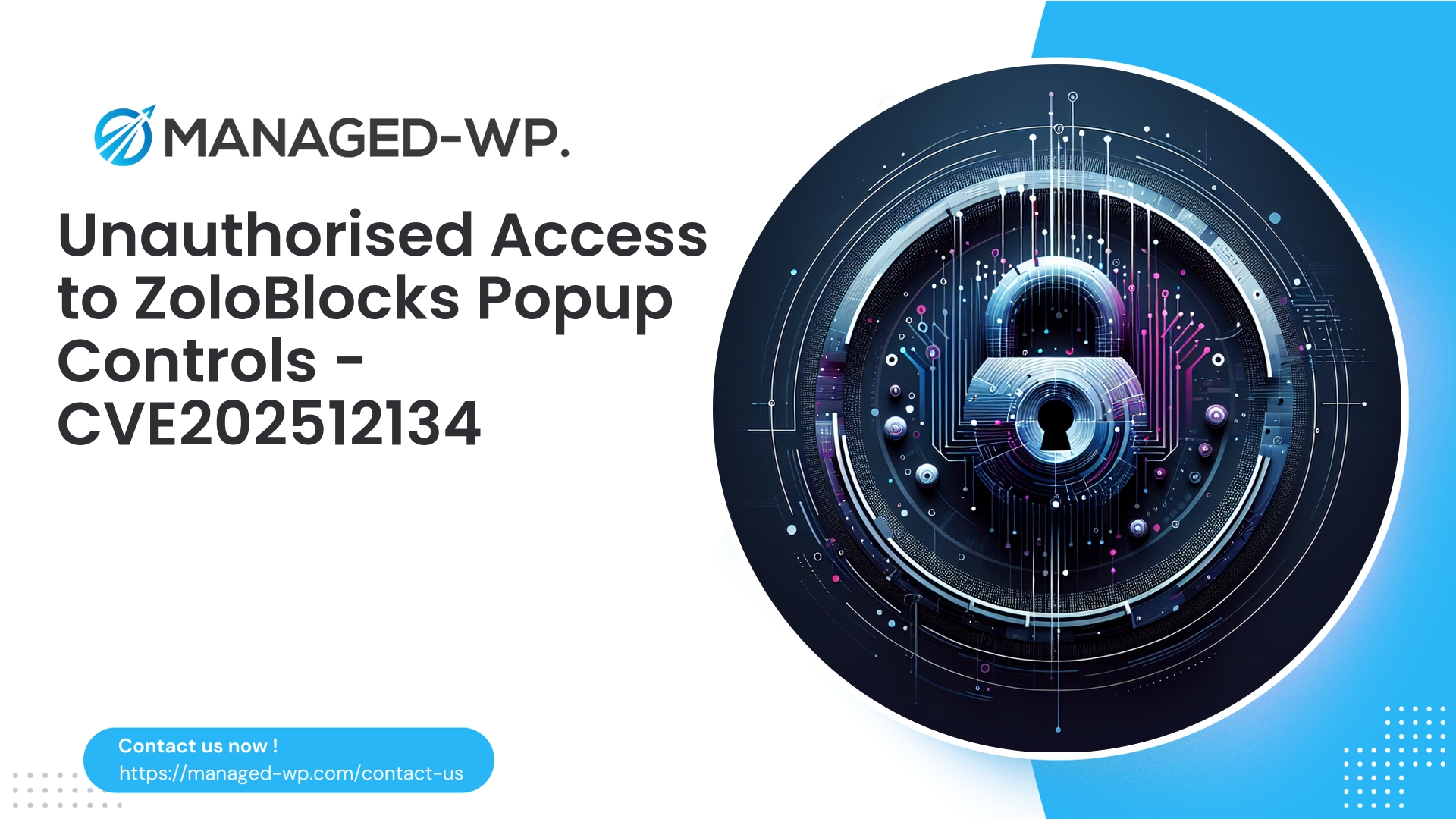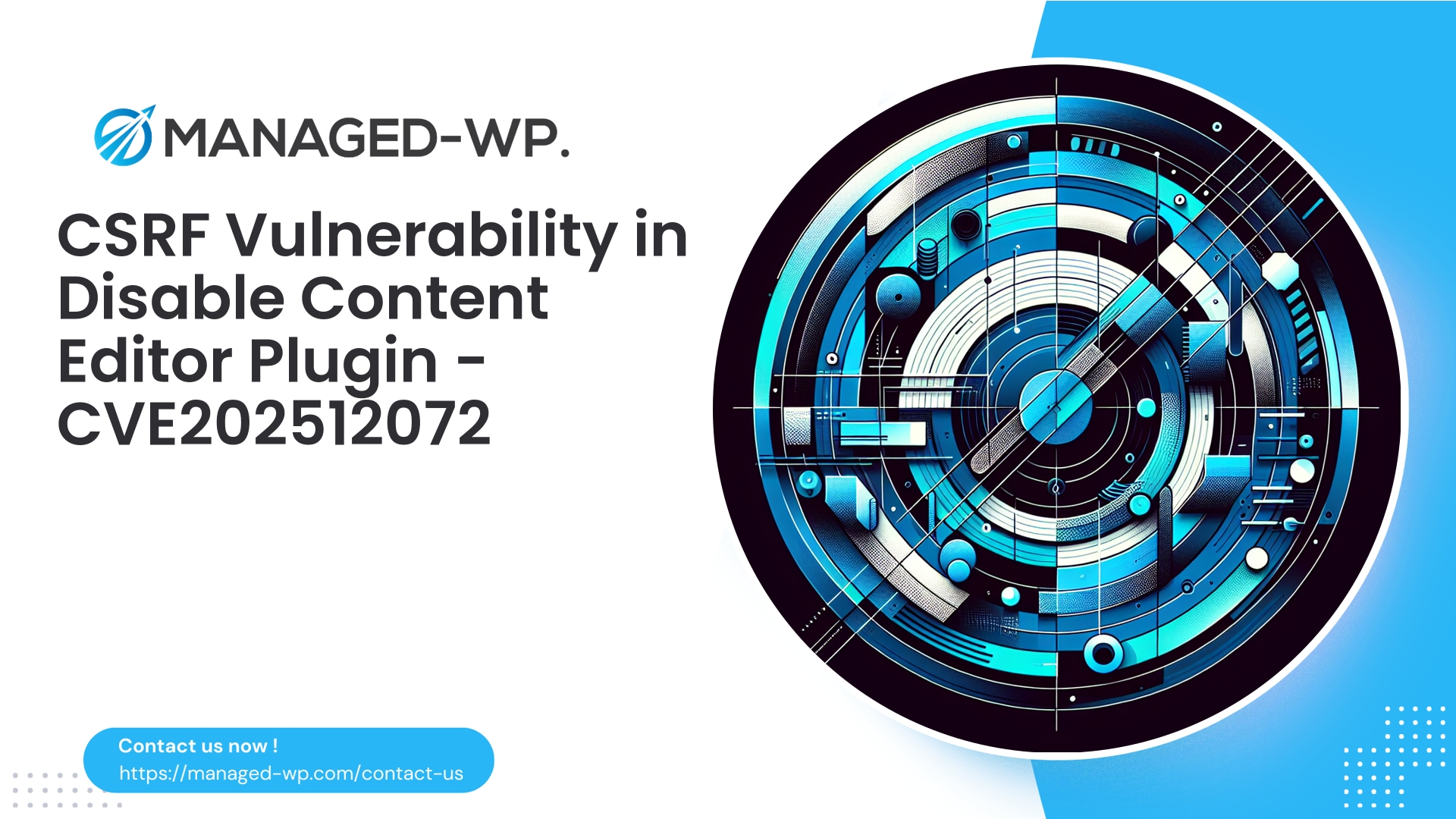| Plugin Name | ZoloBlocks |
|---|---|
| Type of Vulnerability | Authorization Bypass |
| CVE Number | CVE-2025-12134 |
| Urgency | Medium |
| CVE Publish Date | 2025-10-23 |
| Source URL | CVE-2025-12134 |
Urgent Security Alert: ZoloBlocks <= 2.3.11 — Critical Broken Access Control Vulnerability (CVE-2025-12134) and Immediate Steps for Site Owners
Published: October 23, 2025
Attention WordPress site owners: If you are utilizing the ZoloBlocks plugin, versions 2.3.11 and below contain a significant security flaw—an authorization bypass vulnerability identified as CVE-2025-12134. This vulnerability allows unauthenticated actors to enable or disable popup functionality on your site without any permission checks, posing serious risks including phishing, malicious script delivery, and social engineering attacks.
At Managed-WP, a leading US-based WordPress security and managed services provider, we prioritize transparent, expert guidance backed by actionable intelligence. This briefing provides a comprehensive walkthrough covering risk assessment, detection methods, practical mitigations, and ongoing hardening measures to help safeguard your website.
Quick Summary: What You Need to Know
- Affected Plugin: ZoloBlocks versions <= 2.3.11
- Issue: Broken access control allowing unauthorized popup toggling
- Remediation: Immediately update to ZoloBlocks version 2.3.12 or later
- If update is delayed:
- Temporarily disable the plugin
- Apply Web Application Firewall (WAF) rules to block unauthorized requests
- Implement server-level filtering on endpoints (admin-ajax.php/REST API)
- After updating: Conduct thorough site scans, rotate credentials, and audit plugin settings
- Managed-WP Protection: Consider leveraging Managed-WP’s free plan for immediate WAF coverage during remediation: https://my.wp-firewall.com/buy/wp-firewall-free-plan/
Understanding the Vulnerability
The ZoloBlocks plugin exposes an unauthenticated endpoint that manipulates the popup feature without enforcing any authorization mechanisms such as capability checks or nonces. This critical lapse means any external party can toggle popup displays on your site, facilitating phishing attacks, delivering malicious payloads, or leveraging trust-based social engineering tactics against your visitors. Additionally, attackers may exploit this access point as a beachhead for broader attacks.
The vulnerability was publicly disclosed on October 23, 2025, with a security patch incorporated in version 2.3.12. Websites running versions 2.3.11 or older remain vulnerable.
Why Site Owners Should Act Now
- Popup toggling by unauthorized users can inject fraudulent or harmful content, severely damaging user trust and potentially causing direct financial losses.
- This vulnerability does not require any authentication, meaning automated and widespread exploitation is highly likely.
- The exposed attack vector can be a stepping stone for advanced tactics such as targeted cross-site scripting attacks or redirects.
While the vulnerability alone may not result in total site takeover, it represents a serious integrity breach that must be addressed promptly.
How Attackers Exploit This Vulnerability
Attackers commonly exploit endpoints via WordPress’s admin-ajax.php or REST API interfaces. The lack of proper permission checks enables unauthorized HTTP requests that alter popup settings. The typical attack steps include:
- Discovering the relevant action, such as “
admin-ajax?action=zolo_toggle_popup” or REST endpoint “/wp-json/zoloblocks/v1/popup”. - Sending HTTP POST or GET requests with parameters indicating enable/disable commands.
- The server executes these state changes without validating authentication or authorization.
- The attacker activates malicious popups or disables existing protective popups.
Because this is unauthenticated, the attack has low complexity and can be automated for wide-scale exploitation.
Example Attack Simulation (Educational Purposes Only)
Admin-Ajax API curl request:
curl -s -X POST "https://yourdomain.com/wp-admin/admin-ajax.php"
-d "action=zolo_toggle_popup&status=1"
REST API curl request:
curl -s -X POST "https://yourdomain.com/wp-json/zoloblocks/v1/popup"
-H "Content-Type: application/json"
-d '{"enabled":true}'
Note: Do not perform any testing on sites you do not own or have explicit permission to test. These examples are provided to illustrate exploitation methodology only.
Step-by-Step Guidance for Site Owners
- Backup your entire site including files and database before making changes.
- Immediately update ZoloBlocks to version 2.3.12 or later, ideally testing on a staging environment first.
- If you cannot update immediately: deactivate the plugin in WordPress or rename the plugin directory via FTP/SFTP to disable it temporarily.
- Apply preventative WAF rules or server-level filters to block unauthenticated access to the vulnerable endpoints.
- Scan your website for suspicious files or injected content. Review uploads and database entries related to the plugin.
- Rotate all admin and API credentials, including WordPress admin passwords and
wp-config.phpsalts. - Monitor server access logs for suspicious patterns, specifically repeated POST requests to admin-ajax.php or REST routes associated with ZoloBlocks.
- Once updated and cleaned, re-enable the plugin, continuing to monitor site activity closely.
Detection Tips: Indicators of Compromise
- Look for repeated POST requests to
/wp-admin/admin-ajax.phpwith unexpected action parameters. - Monitor REST API calls targeting
/wp-json/zoloblocks/namespaces. - Search wp_options for suspicious toggling of popup-related options:
SELECT option_name, option_value FROM wp_options WHERE option_name LIKE '%zolo%'; - Inspect wp_posts content for unauthorized scripts or iframe injections.
- Check file modification timestamps for unexpected changes:
find . -type f -mtime -7 -print - Identify unknown or unauthorized admin users and sessions.
Because attackers often use automated scripts, frequent and pattern-based anomalies in logs are a strong sign of exploitation attempts.
Example WAF Rules to Mitigate Exploitation
If you manage a Web Application Firewall or can configure server rules, here are templates to block unauthorized popup toggling attempts. Adapt and test thoroughly before deployment.
ModSecurity rule example:
# Block unauthorized popup toggle via admin-ajax.php
SecRule REQUEST_URI "@contains admin-ajax.php"
"phase:2,chain,deny,log,status:403,msg:'Block unauthorized ZoloBlocks popup toggle',id:100001"
SecRule ARGS_NAMES|ARGS "(?i)action=.*(zolo|zoloblocks|zolo_toggle|toggle_popup)" "chain"
SecRule REQUEST_HEADERS:Cookie "!@contains wordpress_logged_in_"
Nginx location block example:
location ~* /wp-json/.*/zoloblocks.* {
if ($http_cookie !~* "wordpress_logged_in_") {
return 403;
}
}
Important: Begin with logging or “detect” mode to monitor before enforcing deny rules. Tailor specifics to your environment.
Temporary Virtual Patch via mu-plugin
If you must keep the ZoloBlocks plugin enabled but cannot immediately apply updates or WAF rules, a must-use (mu) plugin can force popup functionality off to limit exposure.
Create: wp-content/mu-plugins/force-zoloblocks-popup.php
<?php
/*
Plugin Name: Managed-WP Emergency: Force ZoloBlocks Popup Off
Description: Temporarily disables ZoloBlocks popups pending plugin update.
*/
add_action( 'init', function() {
if ( ! defined( 'WPINC' ) ) {
return;
}
// Replace with actual plugin option key identified via database inspection.
update_option( 'zoloblocks_popup_option', 0 );
});
This mu-plugin resets the popup option on every page load, acting as a temporary safeguard—not a replacement for a proper security patch.
After-Action Checklist Post-Update
- Verify that ZoloBlocks is updated to the patched version 2.3.12+.
- Conduct a comprehensive scan for malware, suspicious code, and database injections.
- Rotate all high-privilege user and API credentials.
- Revoke active sessions, forcing password resets for admins.
- Audit WordPress user roles to identify unauthorized accounts or privilege escalations.
- Check scheduled cron jobs for suspicious entries.
- If intrusion indicators are found, consider a full restore from a known clean backup and engage professional remediation services.
Examples of Indicators of Compromise (IoC)
- Requests containing parameters such as
admin-ajax.php?action=zolo_toggle_popup - REST API calls with paths matching
/wp-json/*zoloblocks* - Database option entries toggling popup settings unexpectedly
- New or altered pages with
<script>or<iframe>elements appearing around the time of compromise - Suspicious outbound network connections to unrecognized domains hosting malicious popup payloads
- Recently added or modified files under
/wp-content/uploads/or plugin directories
Best Practices for Plugin Development to Prevent Such Issues
- Enforce capability checks using
current_user_can()for admin-only actions. - Use nonce verification (
check_admin_referer()) to validate requests. - Register REST API endpoints with strict
permission_callbackvalidations. - Always sanitize and validate incoming user input.
- Perform automated security testing to detect missing permission checks during development.
- Have a responsible disclosure policy and patch quickly upon vulnerability reports.
The Critical Role of a Web Application Firewall (WAF)
A well-configured WAF serves as a frontline defense, automatically blocking exploit attempts targeting vulnerable endpoints until patches are applied.
- Stops known exploit signatures against ZoloBlocks and similar vulnerabilities
- Throttles suspicious traffic to limit automated scanning and mass exploitation attempts
- Applies virtual patches providing protection without direct code changes
- Generates alerts and logs supporting rapid detection and response
Managed-WP continuously updates virtual patches and signatures tailored to emerging threats like this one, ensuring customers receive near real-time protection.
System Admin Practical Commands
Find files updated within the last 3 days:
cd /path/to/wordpress
find . -type f -mtime -3 -print
Search the database for suspicious JavaScript injections:
wp db query "SELECT ID, post_title FROM wp_posts WHERE post_content LIKE '%<script%'" --skip-column-names
Check the installed plugin version:
wp plugin get zoloblocks --field=version
Extract admin-ajax.php POST requests from logs:
grep "admin-ajax.php" /var/log/nginx/access.log | grep POST | grep -i zolo
Hardening Recommendations for Long-Term Security
- Maintain updated plugins, themes, and WordPress core through a controlled staging and production workflow.
- Enforce least privilege principles by restricting user capabilities.
- Enable two-factor authentication for all administrators.
- Limit or disable unused features like XML-RPC and restrict admin-ajax.php and REST API access to authenticated users only.
- Implement file integrity monitoring and daily vulnerability scans.
- Maintain offsite, versioned backups and routinely test restore procedures.
- Segregate administrative interfaces from the public site surface via subdomains or HTTP authentication.
What Managed-WP Offers to Protect Your Site
Managed-WP delivers comprehensive WordPress security services combining real-time threat intelligence, managed WAF, and expert incident response.
- Virtual patching that blocks exploit attempts right at the network edge
- Managed rule updates targeting new vulnerabilities as they arise
- Real-time anomaly detection in admin-ajax and REST API traffic
- Dedicated support and remediation guidance tailored to your environment
Partnering with Managed-WP means you can safeguard your site immediately without waiting for plugin updates or manual patching.
Get Started with Managed-WP Protection
Secure your site today with our Free Baseline Protection plan
The Managed-WP Basic (Free) plan includes crucial defenses such as a managed firewall, unlimited bandwidth, WAF, automated malware scanning, and protections against the OWASP Top 10, giving you critical coverage while you update vulnerable plugins.
Sign up now at https://my.wp-firewall.com/buy/wp-firewall-free-plan/
For advanced needs including auto malware removal, IP management, enhanced reporting, and virtual patching, explore our Standard and Pro plans designed for agencies and security-conscious teams.
Final Immediate Action Plan
- Backup your site (files + database)
- Update ZoloBlocks to version 2.3.12 or newer immediately
- If unable to update immediately: disable the plugin or apply WAF rules / mu-plugin workaround
- Scan for any indicators of compromise (files, database, content, users)
- Rotate all admin credentials and update security salts
- Review logs regularly and clear suspicious sessions
- Consider activating Managed-WP free plan for managed WAF protection during remediation: https://my.wp-firewall.com/buy/wp-firewall-free-plan/
- After remediation, schedule regular plugin updates and security audits
If you require assistance implementing these emergency measures, configuring WAF rules, or conducting thorough integrity scans, Managed-WP’s expert team is ready to help. We understand the urgency and pressure that come with live vulnerabilities and provide clear, evidence-driven guidance designed to secure your site quickly and effectively.
Stay safe, stay updated, and secure your WordPress site with Managed-WP.


















